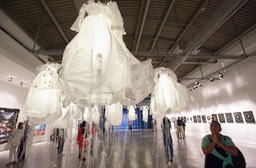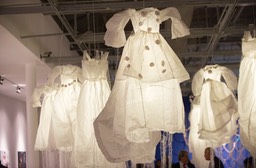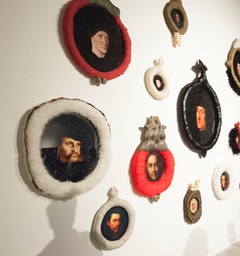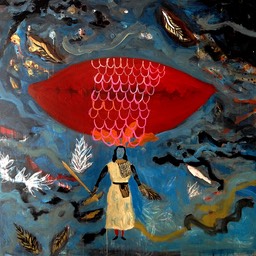Marielle Plaisir’s exhibit at MOCA North Miami explores the historical and ongoing relationships between those in the Caribbean who dominate, and those who are dominated. April 29, 2016 Miami Herald story.
At MOCA North Miami, Marielle Plaisir explores Dynamics of Domination
By George Fishman
The wide-reaching impact of European colonialism in the Caribbean plays out intimately in the lives of individuals, such as artist Marielle Plaisir, whose elegant, playful and brazen works in five interconnected genres are now on display at MOCA in the exhibit, “Actions, Not Words.”
Paper dresses, paintings, video, performance and installation all deal with identity issues — especially the relationships of dominater and the dominated. “All my work is about that,” said Plaisir in a recent interview. This theme arises at least in part from her personal heritage. Plaisir was born in France; her mother is French; her father from Guadeloupe.
“I love Guadeloupe, because I draw my identity from Guadeloupe. My father is black, black, black; my mother is white, white, white... I discovered that my great-great-grandmother was a slave and I think all the work today is from my identity.”
Her father descended from one of Guadeloupe’s black bourgeois families, but her heritage was downplayed while Plaisir grew up and studied art in France. She moved to Guadeloupe in time to experience the upheaval of 2009, when tens of thousands of people took to the streets in a six-week general strike against low wages, massive unemployment and the rising cost of living. The social turbulence and ensuing negotiations highlighted the social and economic injustices that have underlain island life since French colonial times.
It was only when she moved to Guadeloupe that her father spoke about slavery. “We are Caribbean; we live near the United States,” said Plaisir, “but we don’t speak English. We are French; we have a specific culture. We don’t know where we are. It’s very difficult.”
Residents enjoy a certain status associated with France’s centuries of cultural prestige, but most wealth and privilege are still retained by the békés, white descendents of former slave-owners. In 2015, Guadeloupe inaugurated the world’s largest museum in memory of the slave trade, Mémoriale ACTe. Plaisir will exhibit there in 2017.
At MOCA, two walls of Plaisir’s exhibition specifically reference European artistic traditions. Reproductions of Renaissance portraits hang in antique salon style. The selection includes liberated slave Olaudah Equiano, by Joshua Reynolds; Mauresse de Mauret, the illegitimate black daughter of Louis XIV, and works by Van Eyck and Bellini, chosen simply for the power of their gaze.
Instead of using carved wooden frames, Plaisir fashioned soft, stuffed fabric borders and ornaments that suggest both tribal finery and ecclesiastic garb. “I try to find the best medium to express my message, she said, “and I taught myself to sew specifically for this project.” It cost her two sewing machines.
Along the same wall, round delicately painted black-and-white silhouettes are arranged in a line. They recall a style of portraiture expressed by other artists in cut paper, embroidery and engravings – even photography. Plaisir makes fun of the fancy dress, hairstyles and general vanity of the aristocracy by incorporating witty phrases, like “Maybe a false nose” or “Maybe she didn’t marry the king’s cousin.”
Of course, what’s normal in one generation or society is seen as outlandish in another. This disparity underlies her central discourse on identity. As exhibition curator Jorge Luis Gutiérrez pointed out, that phenomenon continues unabated, but today it is aided by technology. “Every day, an average of 95 million selfies are taken,” he said, “and we are checking our phones 100 billion times a day” — all in the service of confirming who we are and how we’re conforming or contravening norms.
Plaisir’s work focuses on European colonization, where privilege and exploitation determined work assignment, food, dress, speech, music, housing. Clothing is her chosen metaphor for reflecting upon the exercise of power.
“Why clothing?” asks Gutiérrez. “Because it’s how we stereotype people.’’ How one dresses, she points out, forms the basis for perceptions and classifications. And from classification, often follows discrimination – whether blatant or subtle.
For this exhibition, Plaisir fabricated 20 billowy translucent white paper dresses and illuminated them like lanterns. Floating overhead, they form a luminous centerpiece and provide a bright decorative charm. Closer examination reveals that half are plain, and the other half decorated with trains, veils, buttons, bows and decorative perforations.
“The dresses are of two kinds: French bourgeoisie and slaves,” explains Plaisir. However, “They’re both in the same space, lighted and white. There’s no power difference between slavery and bourgeoisie, and perhaps I would like to see the world like that… it’s a dream.”
PERFORMANCE
Similar dichotomies recur in the artist’s performances, represented both in a video and in her enactment of silent poses while wearing elegant, colorful period dresses. In the video, she stands anachronistically in a laundromat against a backdrop of actively cycling washing machines, while plainly dressed patrons go about their chore seemingly oblivious to the dissonance.
As Plaisir writes in her introduction, “I will be experiencing the merger of my identity (visible through my physical traits) with another identity (visible through my apparel). I will experience the usurping of a different identity through the apparel.”
During the exhibition opening, where she appeared in elegant colonial dress and performed a silent vigil, and later in a joint performance with baritone Angel Refusé, Plaisir used her hands to invoke the maxim of “see no evil, hear no evil, speak no evil.” This austere pantomime mirrors the generally spare installation and multiple meanings embedded in her work, inspiring reflection and introspection. Gutiérrez calls it a “site of remembrance.”
PAINTINGS AND TAPESTRIES
Using an aesthetic different from her other work, lush fluid paintings and tapestry-like works that re also part of the exhibition reveal the poetic dreamy side of Plaisir’s creative process. In these juicily rendered paintings, she evokes cloudy skies, floral fantasies, children’s books, underwater scenes, myths and dreams. She juxtaposes thick, loosely brushed paint with delicate figurative linework, similar to her silhouettes.
Gutiérrez connects these works to the historical French impulse of dominion over nature, epitomized by the formal garden tradition of Versailles. In Plaisir’s work, we can see that impulse represented by a rapier-wielding dandy, poised as though attacking a fern tree. But he is overwhelmed by giant Chagall-like birds and a tempest of bright flowers, suggestive of an exotic, sensual paradise.
Other pieces in this series juxtapose regally attired horsemen – whether from Asia, medieval Europe or the artist’s imagination – dwarfed by floods of dark and bright preternatural forces. The dream-like quality of these hybrid paintings and tapestries – some framed with upholstery – embody the poetic and chimerical side of Plaisir’s expression. The selection of fine fabrics and the refined handwork skills of haute couture reference both the prestige of France’s fashion tradition and, ironically, the low status given to women’s domestic work. Plaisir nimbly explores this dichotomy of privilege and disdain.
Three simple elements complete the exhibition. Deep blue paint glows from the back wall of the installation. Suspended a few feet in front is a looping latticework, made of multicolored rope that forms an open net or scalloped lace pattern. A wall text reads: “My dream is to recompose the world where there would be neither ‘dominant’ nor ‘dominated,’ where, in the kingdom I build, one could travel through both sides of the mirror.” That’s a challenging dream to realize. “Actions Not Words” is an apt rallying cry.
LOCAL CONTEXT
Plaisir’s exhibition lands on fertile ground and continues discourse around themes of great potency amid the region’s growing cultural significance and political flux.
Understandably, Miami benefits from considerable exploration of post-colonial themes. Pérez Art Museum Miami’s (PAMM) 2014 exhibition, Caribbean, Crossroads of the World displayed a spectrum of attitudes regarding Old World norms – from the paradoxical adoption of royal portraiture in newly-independent Haiti to caustic satire, self-mockery and “anti-historical” work by such artists as Jamaican Renée Cox.
PAMM also featured solo shows by Edouard Duval-Carrie and Adler Guerrier, who presented landscape as historical locale, fantasy and refuge. Jamaican-born Nari Ward, whose work is largely rooted in North American social dynamics, was given regional relevance and context through Diana Nawi’s curatorial touch. And Firelei Báez’s recent paintings brazenly but lovingly examine the layers of cultural and psychological freight contained within hairstyles, skin color, body shape and clothing of Caribbean women.
The NSU Museum of Art featured photography From Within and Without Haiti, documenting the convoluted knot of emotional and political attitudes that characterize Haitians’ cultural response to phases of conquest and liberation. These, along with the Frost Art Museum and MDC Museum of Art and Design are among the major museums exhibiting visual arts and hosting performances by Caribbean artists.
Because of the unique physical, political, familial and artistic connections between Miami and Cuba, artists from that nation receive heightened attention, as in the annual CINTAS fellowship exhibitions and innumerable gallery shows. And independent curators including Rosie Gordon Wallace, Marie Vickles and Carl Juste, a Miami Herald photographer, have produced exhibitions, residencies and symposia showcasing the English and French-speaking islands at The Little Haiti Cultural Center and other venues.



